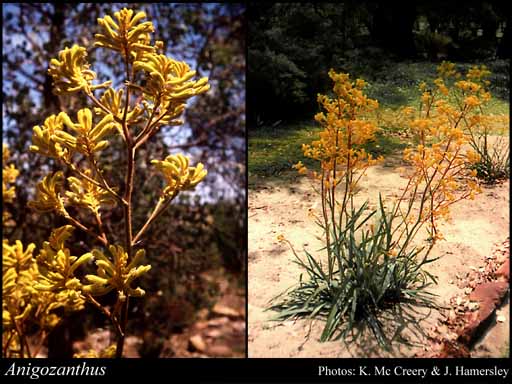- Reference
- Voy.Rech.Pérouse 409, 410 [octavo ed.] (1800)
- Name Status
- Current

Scientific Description
Common name. Kangaroo Paws. Family Haemodoraceae.
Habit and leaf form. Herbs; with coloured juice, or non-laticiferous and without coloured juice. Perennial. Leaves basal and cauline (mainly basal with a few small cauline leaves). Plants with a basal concentration of leaves (leaves all radical); rhizomatous (short, horizontal, not red internally). Rhizome and root tissues brightly red-pigmented, or not red-pigmented. Mesophytic, or xerophytic. Leaves medium-sized to large; alternate; distichous; leathery; sessile; sheathing. Leaf sheaths with free margins. Leaves edgewise to the stem, or with ‘normal’ orientation; simple; epulvinate. Leaf blades entire; flat, or solid (or subterete); linear (or ensiform); linear; parallel-veined; sheathing. Leaves without stipules. Leaf blade margins entire. Leaves with a persistent basal meristem, and basipetal development. Vernation conduplicate. Leaf anatomy. Guard-cells not ‘grass type’. Hairs present, or absent (more frequently). Branched hairs present. Extra-floral nectaries absent. Stem anatomy. Secondary thickening absent.
Reproductive type, pollination. Fertile flowers hermaphrodite. Unisexual flowers absent. Plants hermaphrodite. Floral nectaries present. Nectar secretion from the gynoecium (via septal nectaries). Entomophilous, or ornithophilous, or pollinated by unusual means.
Inflorescence and flower features. Flowers aggregated in ‘inflorescences’; in racemes (1-sided), or in spikes (1-sided). The terminal inflorescence unit cymose, or racemose. Inflorescences scapiflorous; terminal; scape simple or forked or paniculate; inflorescence pubescent, few or many flowered. Flowers subsessile; very irregular; when irregular, zygomorphic; 3 merous; cyclic; tricyclic, or tetracyclic. Perigone tube present. Perianth of ‘tepals’; 6 (in 1 whorl); 1 -whorled; isomerous; petaloid; similar in the two whorls; green, or yellow, or orange, or red, or black (blackish; all colours due to coloured plumose woolly hairs). Androecial members definite in number. Androecium 6. Androecial members adnate; all equal; free of one another; 1–3 -whorled. Androecium exclusively of fertile stamens. Stamens 6 (in 1–3 series); all more or less similar in shape; isomerous with the perianth, or diplostemonous; near the base of the perianth lobes; alterniperianthial. Filaments appendiculate, or not appendiculate. Anthers basifixed; versatile, or non-versatile; dehiscing via longitudinal slits; introrse; appendaged (sometimes small, apical), or unappendaged. Gynoecium 3 carpelled. The pistil 3 celled. Gynoecium syncarpous; eu-syncarpous; partly inferior, or inferior. Ovary plurilocular; 3 locular. Gynoecium stylate. Styles 1; when 3, partially joined; attenuate from the ovary, or from a depression at the top of the ovary; apical; much longer than the ovary at anthesis. Stigmas 1; capitate. Placentation axile. Ovules 2–100 per locule (many); non-arillate; orthotropous to hemianatropous.
Fruit and seed features. Fruit non-fleshy; dehiscent; a capsule. Capsules loculicidal (in upper part). Fruit 3 celled; few. Seeds copiously endospermic. Endosperm oily. Seeds winged, or wingless. Cotyledons 1. Testa without phytomelan.
Etymology. The derivation is obscure, and as the genus provides the floral emblem of the State of Western Australia, a treatment fuller than normal may be warranted. La Billardiere does not mention a meaning in his original description. C.A. Gardener derived the name from the Greek for "unequal" and "flower", and assumed that the g was inserted for euphony. This derivation accords with La Billardiere's description [translated]: ‘it forms, nevertheless, a new, very distinctive genus, principally on account of its irregular corolla’. ‘The corolla is in the form of a tube divided at its extremities into six unequal parts’. D. Don (1836) derived the name from the Greek for "to elevate" and "flower", ‘from its flowers being elevated on a naked stem’. James Drummond (1843) stated that the genus ‘was named from a fancied resemblance to the plumes on horses and mourning coaches’. The Canberra Botanical Gardens (1972) derive the name from the Greek for "to open, undo" and "flower" ‘alluding to the open branching of the flower stems’. La Billardiere makes no mention of this characteristic.